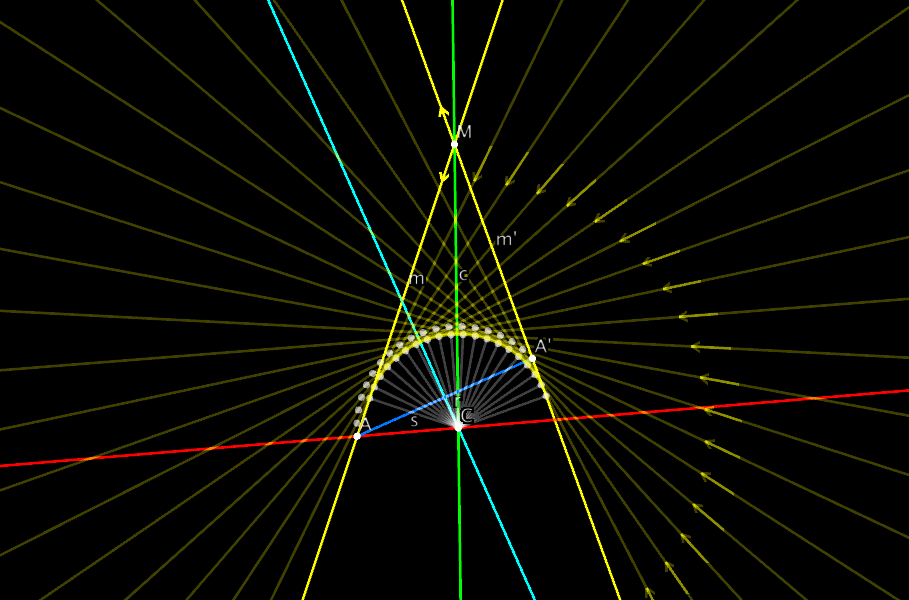[Question to my readers: is there a way to get a compact enumeration in this blog? If I write a list using the list menu item in the wordpress editor, the entries are v e r y f a r a p a r t.
This post picks up where the last one left off. Our task here is to present the essentials of projective geometric algebra and use to obtain a metric-neutral formulation of the solution to the problem discussed in the previous two posts.
Projective space to the rescue. To obtain the projective models of the metric planes of interest, begin with the vector space
Duality to the rescue. We can do the same with the dual algebra. Then the 1-vectors are lines and the wedge operation is the meet of two lines. By a little bit of abstract nonsense, we can in fact restrict our attention to one of these algebras and “import” the other wedge product when we need it (by using Poincare duality, the details are in my thesis). For our purposes we write the join operator as
Adding a metric. To work in the metric relations, we have to incorporate the inner product with this outer product. To do so we define three different signatures for our inner product: (+++), (++-), and (++0), which corresponds to elliptic, hyperbolic and euclidean plane, resp. Write the inner product of two 1-vectors with respect to the chosen inner product as
Why (++0) is euclidean: In
Why we have to use the dual algebra: If you’re wondering why we started with the dual exterior algebra, that answer is: because that’s how God make the world we live in. Euclidean lines are less degenerate than euclidean points. If you try to start with the standard exterior algebra (where 1-vectors are points) you cannot obtain euclidean geometry; you end up with dual euclidean geometry, in which points are less degenerate than lines, which does not at all match up with the space we live in. (It’s a fascinating space in its own right and I hope to post something on it in the near future.)
Normalizing. It’s useful to work with normalized points and lines. To obtain this normalization, notice that
Implementing the construction. Here are the steps of the construction, translated into
References: my thesis, a euclidean extract
Exercise. Express the exceptional configurations described in the previous post, in terms of the geometric algebra description above.
Remarks on isometries as rotors instead of matrices. I’d like to close this post by discussing the representation of isometries in the context of PGA (projective geometric algebra). Note from the above formulae that a reflection in a proper line can be written as a “sandwich operator” with the line as the “bread” (appearing on left and right) and the object to be reflected as the meat (in the middle). This should be familiar to readers who know about the representation of quaternions as sandwich operations. Concatenating an even number of such reflections leads to direct isometries, as the expression for the rotation
Terminology. A product of 1-vectors is called a versor; a product of proper 1-vectors is a proper versor. A proper versor is then an isometry of the geometry, and any such isometry may be written as a versor. A product of an even number of 1-vectors is called an even versor; every direct isometry represents a direct isometry, and (with a few exceptions) vice-versa. An even versor is also called a rotor, due to the obvious connection to rotational motion. The set of proper rotors, normalized to have norm 1, forms a group, the spin group of the algebra, written Spin. The full set of proper versors also forms a group, the pin group, written Pin.
Notation. In order to express the sandwich operation with a k-versor succinctly, we write the versor as
Advantages of this approach. The existence of a versor representation for isometries in the metric space (or plane, as here), means that one no longer needs to rely on linear algebra for this representation. No more matrices! Seriously, the advantages of the versor approach are worth pointing out. We restrict our attention to the two dimensional case we have been discussing to make things easy to understand; but the observant reader can easily extrapolate to higher dimensions. In the first place, the representation is grade-independent, meaning the meat of the sandwich can be any grade; the result of the sandwich operation will represent the isometry applied to the meat. Compare this to linear algebra, where the transformation matrix for an isometry applied to a point is not the same as that applied to a plane (one is the adjoint of the other). A further advantage of the versor formulation is that the the isometry can be read off from its versor representation. For example, for a 1-versor, the isometry is the reflection in the line which the versor represents. For a rotor, the isometry is a rotation whose center is given by the grade-2 part of the versor, through an angle equal to
The final advantage of the versor representation is that every rotor has an exponential representation (just as a unit quaternion does). Since
The following figure shows 20 equal steps in the interpolation of the isometry obtained in this way. The interpolated lines are are drawn as transparent objects to reduce the clutter in the image. You can see that the envelope of the moving line is a circle.
If you’re still with me, I hope that you have gotten a taste of how projective geometric algebra can be a powerful, practical, and elegant tool for doing geometry in a metric-neutral way.


Pingback: Introduction to projective geometric algebra, II | Mathematical Visualization